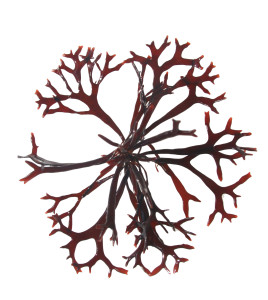
Carrageenan is a thickening agent and stabilizer. It is derived from seaweed. Would you believe it is frequently used in dairy products? One example is commercially formulated chocolate milk.
Thickening the base imparts a feeling of creaminess to the milk. And yes, this seaweed derived thickener is a major ingredient in less expensive (read: cheap) brands of ice cream.
Vegetarians
Its origin makes carrageenan a natural for vegetarian products. One historically important variety comes from Chondrus crispus seaweed. It is very often called Irish Moss. It replaces animal based gelatin. Another well known form comes from the seaweed Gigartina stellata (which is called Carrageen Moss).
Chemically
Chemically, the thickener is not simply one substance. It is a whole family of substances, the sulfated1 polysaccharides2. Members of the family are categorized by their structure, which reflects the ability or inability to form gels.
Who May Eat Carrageenan
The most controversial use of this food additive is in baby formula. The U.S. permits its use (why is that not surprising?), whereas the European Union (EU) disallows it.
1 The sulfur and oxygen containing sulfate group is written –OSO3
2 Polysaccharides are complex compounds consisting of linked sugar molecules. The sugar units are galactose and 3,6-anhydrogalactose.
Note: You might also enjoy Instant Pudding Thickening Chemistry
References:
- FAO: Production, Properties, and Uses of Carrageenan
- Cyber Colloids Ltd: Introduction to Carrageenan Structure

We eat seaweed in the Celtic countries. In Ireland, the seaweed eaten is called “Dulse”. It is dried and sold in local shops in small packets. It is salty and fairly crisp and can be eaten as a snack. In Wales, the seaweed eaten is called “Laver bread”. It is rather like a thick, glossy black porridge in consistency. It goes well being fried in the frying pan after cooking bacon and eating the two together. Both contain iodine, which is an important chemical in the body.